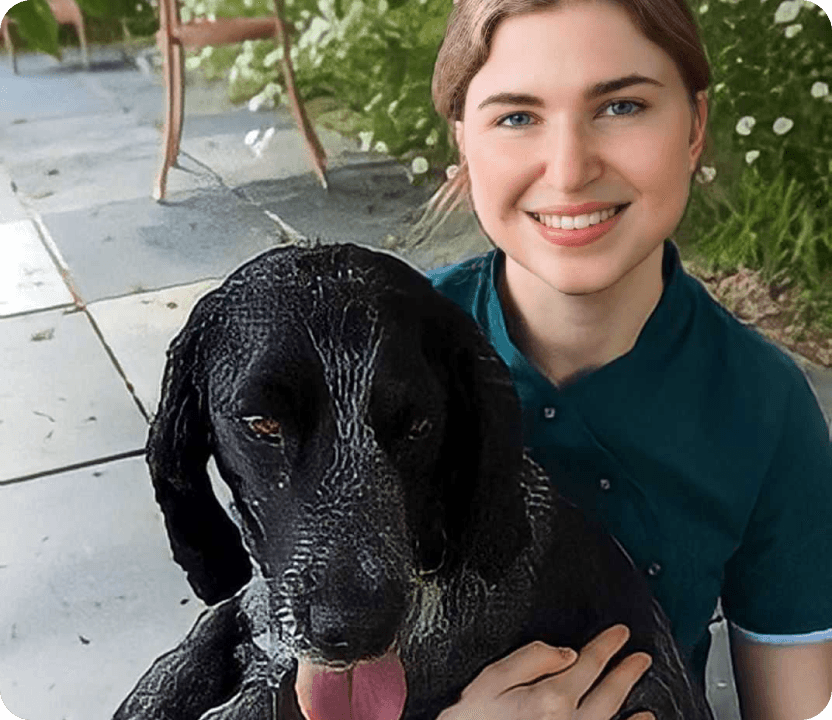Dog joint swelling may not be noticeable to a blind eye. Learn to recognize the signs and symptoms to help your pup feel more comfortable.
- Home/
- Dog/
- Health & Wellness/
- Swollen Joints in Dogs: 10 Possible Causes & How to Help
Swollen Joints in Dogs: 10 Possible Causes & How to Help

Whether you have two legs or four, a swollen joint is usually a cause for concern. A wide range of conditions can cause joint swelling in dogs. But which are the most common and what signs should you be looking out for? How urgently does your dog need to see a veterinarian, and what’s the treatment likely to be?
In this article we’ll discuss all of this, giving you the best possible chance of working with your veterinarian to get to the bottom of things – and get your dog feeling better.
What Does Dog Joint Swelling Look Like?
Joint swelling in dogs can range from mild swelling that’s invisible to the eye to severely swollen joints that are clearly enlarged.
Visible swelling usually indicates severe inflammation, and these joints often have a rounded appearance.
Milder swelling can be difficult to see and is much easier to feel. It’s often easiest to feel the same joint on each side of the body to compare. If the small protrusions of bone around the joint are harder to feel and the soft tissues feel thicker, this usually indicates swelling.
Imaging (X-rays, a CT or an MRI scan) is the most accurate way to detect subtle swelling or swelling of deeper joints like the hip.
Where Do Swollen Joints Occur in Dogs?
Swollen joints can occur anywhere in a dog’s body. However, some are more commonly affected than others. Certain locations of the swelling can make specific conditions more likely.
A dog with a swollen joint in their front leg is most likely to have a swollen elbow or wrist (carpus). Arthritis is common in these joints, in addition to elbow dysplasia in younger dogs. In growing puppies, fractures of these joints after a big jump or fall are also possible.
A dog with a swollen joint in their back leg is most likely to have a swollen hock (ankle) joint or stifle (knee) joint. The knee is a common site of joint problems and swelling in dogs. Common conditions that should be considered in dogs with a swollen joint in the back leg include luxating patella, cranial cruciate ligament injury, and arthritis.
Causes of Joint Swelling in Dogs
1. Arthritis
Arthritis means inflammation of a joint. Unsurprisingly, it’s one of the most common causes of joint swelling. Other signs include warmth, pain, stiffness and a crunching sensation when the joint is moved (crepitus).
It can affect almost any joint in the body, though the most commonly affected are the hip, elbow, lower back, knee (stifle), and wrist (carpus).
Arthritis commonly affects multiple joints, including the same joint on both sides of the body (but not always). Dogs may also experience a flare-up in a specific joint if they’ve landed awkwardly on one leg, for example.
While an acute flare-up may cause swelling to become noticeable, arthritis is a chronic condition. Affected dogs are likely to show longer-term signs of stiffness and pain, although these can be subtle in the early stages.
2. Cranial Cruciate Ligament (CCL) Injuries
Cranial cruciate ligament rupture is one of the most common orthopedic problems seen in dogs.
While it often occurs suddenly during exercise, trauma is rarely the true cause. CCL ruptures typically occur as the end-result of a chronic degenerative process, meaning it’s common for both knees to be affected within a couple of years.
CCL rupture usually causes sudden, fairly severe lameness and can lead to visible swelling. But partial ruptures and milder clinical signs are seen in some dogs. Some dogs may have chronic, waxing and waning lameness for weeks to months before diagnosis.
3. Elbow Dysplasia
Joint dysplasia is the result of abnormal cartilage development in growing joints. Elbow dysplasia is one of the most common forms and typically affects large or giant breed dogs at around 4 to 8 months of age.
Elbow dysplasia develops slowly, causing chronic lameness that’s often worse after rest or excessive exercise, and in some cases joint swelling.
It can also contribute to early-onset arthritis, resulting in longer-term lameness and swelling.
4. Luxating Patella
Patellar luxation is a common cause of knee problems and can cause joint swelling in dogs.
The patella, or kneecap, usually sits in a groove on the front of the knee and moves smoothly up and down as the knee flexes and extends. However, in some dogs it flicks out of this groove.
Depending on the severity of the patellar luxation, the kneecap may flick out temporarily with little pain and flick back in after a couple of ‘skipping’ steps, or it may cause more severe lameness.
Mild patellar luxation may not cause many problems, but more severe cases can cause joint inflammation, swelling, and pain. It can also contribute to the development of arthritis.
5. Immune-Mediated Polyarthritis (IMPA)
IMPA develops when the immune system mistakenly identifies the tissues of the joints as a threat and begins to attack them.
This typically causes swelling, pain and stiffness across multiple joints, which often develops fairly rapidly. Dogs may develop ‘shifting lameness’ where different legs seem to be affected at different times. They may also have a high temperature, go off their food and seem lethargic.
IMPA can affect dogs of any age or breed, and in many dogs no specific cause is identified. However, it can occur as a result of an infection, gastrointestinal disease, or cancer.
6. Septic Arthritis
Septic arthritis describes inflammation of a joint due to infection within it.
It usually develops after a penetrating injury, such as a bite or other trauma, introduces infection (typically bacterial) into the joint space. Occasionally, infection may develop without trauma due to infection travelling in the blood or immunosuppression.
Septic arthritis usually affects a single joint and can cause significant pain and swelling. Dogs may also develop a fever and be generally unwell. This condition is a medical emergency, as the infection can rapidly progress and cause permanent damage to the joint.
7. Lyme Disease
Lyme disease is one of the most common diseases transmitted by ticks. It can cause vague, non-specific signs, making it challenging to diagnose.
One of the most common symptoms is recurrent, shifting lameness that can vary between legs over days to weeks. Affected joints can be swollen, warm, and painful.
Other symptoms include lethargy, swollen lymph nodes, and poor appetite. Some dogs may develop kidney issues, leading to excessive drinking and urination.
8. Dislocations & Fractures
These are usually caused by trauma and – unsurprisingly – often cause severe pain and swelling.
However, they can be sneakier than you might expect. Relatively minor bumps and falls can cause a fracture in a puppy. And while we often think of fracture causing severe lameness, some dogs with fractures or dislocations may continue to walk on the affected leg.
It’s important to treat a dislocation or fracture sooner rather than later. If your dog develops sudden joint swelling and pain after any kind of trauma, it’s always worth getting them checked.
9. Cancer
Unfortunately, cancer can affect almost any part of your dog’s body. That includes the bones and joints. The most common types are osteosarcoma and chondrosarcoma, both of which can cause gradually developing lameness and firm swelling around a joint.
Bone cancers tend to be very aggressive and can eventually cause severe pain. They can also predispose dogs to so-called ‘pathological’ fractures, caused by only mild trauma. Other signs include lethargy and weight loss.
These cancers are most commonly seen in older dogs belonging to large breeds, such as Rottweilers, Great Danes and Golden Retrievers.
10. Bleeding
Rarely, dogs can develop ‘hemarthrosis’, or bleeding into a joint. This can be caused by trauma but is also seen in dogs with bleeding disorders, including those that have ingested rat poisoning
Diagnosing the Cause of Swollen Joints in Dogs
Your veterinarian may recommend a range of investigations to get to the bottom of your dog’s joint swelling. Which tests are needed and in what order depends on your dog’s history and clinical signs.
Sometimes a combination of a thorough history and clinical examination is enough to give your vet a strong suspicion of the likely cause. Videos of your dog walking from the side and from behind can be helpful for your vet to pinpoint the cause of swollen joints in dogs.
Potential tests include:
Blood tests – Blood tests can give a good overview of how any disease is affecting your dog’s organs and how your dog’s body is responding. More specialised tests for Lyme disease, clotting times, or parasites that can contribute to bleeding disorders may also be recommended.
Imaging – Radiographs (X-rays) can diagnose some causes of joint swelling. More detailed imaging with a CT or MRI scan may be recommended for more complex cases.
Joint tap (arthrocentesis) – To diagnose conditions like septic arthritis and IMPA, a sample of joint fluid can be collected in a sterile manner. This is then assessed under the microscope and cultured to identify any infection.
Treating Swollen Joints in Dogs
The right treatment for swollen joints in dogs depends on the cause. With so many potential causes, it’s definitely not one-size-fits-all.
Potential treatments for joint swelling in dogs include:
- Activity modification, ranging from crate rest to restricted walks
- Anti-inflammatories and other pain relief
- Supportive treatments such as physiotherapy and hydrotherapy
- Weight management. This is crucial for pets with arthritis, elbow dysplasia and other long-term joint conditions
- Surgery to treat conditions such as cruciate ligament rupture, fractures and patellar luxation
- Antibiotics to manage septic arthritis or Lyme disease
- Immunosuppressive medications to treat immune-mediated polyarthritis
Your veterinarian is the best person to give you personalized advice on both the treatment of your dog’s swollen joints and things you can do at home to support their recovery.
Tips for Protecting Your Dog’s Joints
Once any swelling has gone down and your vet has given your dog the all clear, there are some simple steps you can take to help support their joint health. These include:
Adjust Their Exercise Routine
For dogs with elbow dysplasia, patellar luxation, arthritis and other conditions, sticking to regular gentle exercise can make a world of difference. Work out a level of exercise your dog is comfortable with and stick to it.
Switch Out the Ball Thrower
Unfortunately, dogs are prone to overdoing it when playing games like fetch and frisbee. Sudden, twisting leaps in the air and abrupt stops to catch the ball can put a lot of strain on their joints. Try scent work, puzzles, and training tricks instead.
Keep Them at a Healthy Weight
Last, but definitely not least, this is one of the most important things you can do to prevent swollen joints in dogs. With around 50 percent of dogs now overweight or obese, excess weight has become the norm. But this extra weight impacts almost every body system, including your dog’s joints. Whatever stage of life they’re at, keeping them a healthy weight is key to looking after their joints.

 P
P



